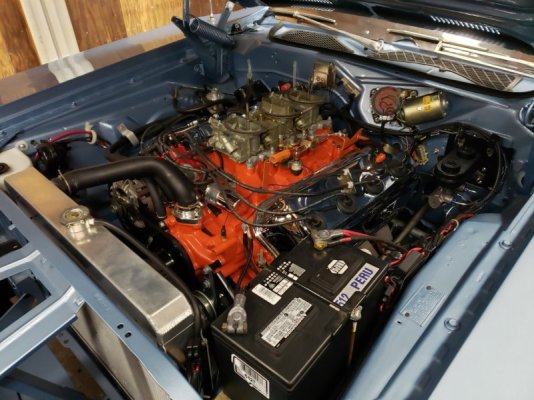There’s a thread on here somewhere that goes into incredible detail about “how to” for a six pack set up. I had it for a long time because I also had a 68 X which I put the whole setup on and needed help tuning too. I just can’t remember who posted it. ,ay have been
@Bob renton or maybe
@kiwigtx can help you find it. It’s a more than you ever wanted to know thread posting.
I dug around my old hard drives and found this article that I saved many years ago from here at FBBO probably......it may be of some help to some.
Holley Carb basic tuning tips
Four-Barrel Fundamentals 12 great setup and tuning tips for the Holley carburettor
Story by Barry Kluczyk
Sure, we know the standard carburettor on just about every performance Poncho was a Rochester. But when it comes to building higher-performance engines, many turn to the venerable Holley four-barrel.
But in this age of electronic fuel injection, however, fewer and fewer enthusiasts know their way around the venturis, jets and power valves of a traditional carburettor. In fact, the perception that setting up and tuning a carburettor is complicated for those with limited experience is enough to turn them off altogether.
It’s true that the variety of adjustable components on a typical four-barrel carburettor allows for an almost infinite number of tuning scenarios, but there are a few basic steps to help select, set up and tune your carb with surprising precision. In fact, even if you’ve never turned a screw on a Holley four-barrel, you should feel confident about installing one and getting your engine to run and idle very close to an optimal tune.
For this story, the tips are based on applications using a Holley 4150/4160-type vacuum-secondary four-barrel (the non-Dominator-type), but most are applicable to other popular carburettors – even singe- or two-barrel models, as well. And to illustrate the tips more clearly, we’ve posed the carb on a Professional Products Hurricane 326-455 intake manifold (part number 56031).
With the following dozen tips to guide your way, you’ll have that carburettor breathing right and giving your Pontiac the crisp, immediate throttle response that just isn’t available with electronic fuel injection.
1. Don’t super-size it. When selecting a carburettor for your engine, don’t overdo it. Generally speaking, a mild-to-moderate street engine doesn’t need more than a 650- or 750-cfm carburettor. To zero in on the most appropriate carb size, multiply the cubic-inch displacement and maximum rpm and divide the product by 3,456. For example: a 350-engine multiplied by a 5,500-rpm redline and divided by 3,456 equals 557, or at least 557 cfm. In that case, a 650-cfm carb is sufficient. It’s OK to go a
little larger than necessary, but don’t choose a carb that’s rated at less than the minimum requirement.
2. Timing is everything. If the first couple of starts don’t produce a quick firing and idle – even if they’re not perfect – don’t jump to the conclusion that it’s a carb-tuning problem. A hard-starting scenario could very well be due to improper ignition timing. So, before cursing the carburettor as you’re ripping it off the intake manifold, double-check the ignition timing. Even an inaccuracy of only a few degrees could produce a hard-start/no-idle condition.
3. Vacuum secondaries vs. the double-pumper. Here’s a simple formula: Use a vacuum-secondary carburettor on midsize and large cars with an automatic transmission. Go with a “double pumper”-type mechanical-secondary carb when using a manual transmission application or with smaller cars that have a radical cam profile or are going to see a lot of time on the drag strip.
4. Power valve power play. The power valve is a vacuum-activated feature that’s used to enrich the fuel mixture to prevent detonation or stumbling (think “metering rod” on a Carter-style carburettor). They’re available in different sizes to match the flow requirements of the engine. On manual-transmission applications, a standard 6½-inch power valve is adequate if the vacuum reading at idle is above 12 inches. For automatic applications, if the idle vacuum reading is below 12 inches, divide the number in half to determine the correct power valve size. For example: a 9-inch vacuum reading requires a 4½-inch power valve.
5. Installing the electric choke. A key-on hot lead wire is connected to the positive (+) spade on the choke cap; and the negative (-) spade on the choke cap is wired back to the carb as a ground. It sounds simple enough, but many installers get it wrong. Now you don’t have to be one of them.
6. Electric choke fast idle adjustment. With the engine
off, hold the throttle wide open; this drops a lever with a ¼-inch screw in it beneath the choke housing. To slow the idle, turn the screw counterclockwise. Turn it clockwise to increase the idle speed.
7. Basic fuel level adjustment. A too-low fuel level in the fuel bowl can cause stumbling when the throttle is opened quickly. Follow these simple steps to adjust it:
Remove the sight plug on the side of the fuel bowl.
With the engine running, loosen the lock screw on top of the fuel bowl.
Turn the nut on the fuel bowl clockwise to lower the fuel level and counterclockwise to raise the fuel level until the fuel is level with the bottom of the hole.
8. Mixture screw setup: Getting the mixture screw adjusted properly is a must for preventing lean or rich conditions. Follow these steps:
Bring the engine to normal operating temperature and turn it off.
Turn the mixture screws all the way in and, then back them out three full turns.
Restart the engine
With the engine idling at temperature, turn one screw in a quarter-turn and the next screw in a quarter-turn, repeating the process in quarter-turn increments until the engine rpm drops.
When the rpm drops, turn the screws back out a 1/8-turn.
9. Selecting the right-size jets. Whether you call them shooters or jets, installing the correct-size components is essential for smooth operation and stumble-free acceleration. Because every application is different, settling on the correct shooter size (orifice diameter) often comes down to trial-and-error tuning. Stumbling at take-off
without black smoke from the tailpipe means the shooters/jets are too small. Stumbling
with black smoke from the tailpipe means the shooters/jets are too large. Crisp, stumble-free acceleration and optimal vacuum mean the shooters/jets are just right.
10. Trouble-shooting bogging and hesitation. Bogging or hesitation is annoying and gives the impression of low horsepower. It occurs when the secondaries come in too soon; and it can be corrected with a heavier secondary spring. Conversely, sluggish performance, especially at wide-open throttle, may be due to a too-heavy secondary spring. Swap in a lighter one.
11. Overcoming stumbling. Stumbling is a common malady experienced with a new or rebuilt carb that makes one wish for electronic fuel injection. But it’s pretty easy to diagnose and cure.
A stumbling condition at take-off is usually due to an inadequate accelerator pump fuel shot – assuming the shooter/jet size is correct (see above). Inspect the pump shot with the engine off. Look into the carb and move the throttle; fuel should spray the instant the throttle is moved. If it doesn’t, turn the nut of the pump arm counterclockwise one full turn and check the spray again. Continue until the spray is immediate with the throttle. If the pump spray is immediate upon inspection, check the following:
Inspect the pump diaphragm for a hole.
Check the pump passage for debris or other impediments.
12. Dried out. If you’re using an old carburettor that has sat unused for a long time – such as the time it took to remove, rebuild and reinstall the engine – it’s pretty common for the gaskets in the metering block to dry out and/or shrink, causing idle problems. If everything else seems to check out, a rebuild of the carb to replace the old gaskets will likely do the trick.
Overdrive Transmission Compatibility
When using a Holley vacuum-secondary carb on a vehicle with a non-electronic overdrive automatic transmission, such as the 200-4R or 700R-4, a throttle kick-down bracket must be used. Otherwise, the transmission’s throttle valve (TV) cable won’t be positioned properly. When that happens, the transmission will shift too early or too late and the line pressures won’t be correct, which will eventually (and probably quickly) cause catastrophic (and expensive) transmission problems. The brackets are available from a variety of aftermarket vendors, such as TCI and B&M.
1 It’s very easy to over-carb an engine, which makes accurate tuning almost impossible, as the too-large carburettor will simply dump too much fuel into the engine. Follow the sizing formula described in the main text’s #1 tip to zero in on the right size for your engine.
2 Don’t assume a hard-starting or stumbling condition is strictly carb-related. Incorrect ignition timing is a common problem on rebuilt and crate engines. Break out your timing light and double-check the timing before cracking open the carburettor.
3 This may sound beyond basic to many, but you’d be surprised how many people install the carburettor backwards on the first try. Remember: The carb mounts with the throttle linkage on the driver’s side of the engine … err … unless you’re reading this in Australia or Great Britain.
4 This diaphragm identifies this carburettor as one with vacuum-operated secondary venturis. For most automatic-equipped, mild-to-moderate horsepower applications, it’s the way to go. Save the double-pumper carb for manual transmissions and higher-horsepower engines.
5 Access to the fuel jets (also known as shooters or squirters) and power valve is gained by unbolting the fuel bowl (and typically some gentle prying to break the seal of the gasket). Regardless of whether the carb is a double-pumper or vacuum-secondary-type, Holley four-barrels have jets and a power valve behind the fuel bowl on the metering block.
6 With fuel bowl removed, the power valve and jets are easy to reach. They’re attached to another removable component called the metering block. The power valve is the larger, centred component, with the jets located below it.
7 The jets are numbered, with larger numbers indicating larger-diameter orifices for the fuel to flow through. Removal and installation is as easy as screwing them in or out with a flat-blade screwdriver. When changing jets, experiment in small-size increments, as minor jet size changes can have a comparatively large effect on performance.
8 Changing the power valve requires removal of the metering block in order to loosen it from the carb side of the metering block.
9 Look closely at the connection points for the electric choke mechanism and you see “-“ and “+” symbols. The negative spade grounds the choke back to the carburettor, while the positive spade is connected to a key-on hot lead.
10 The fast idle adjustment arm lowers into adjustment position when the throttle is held wide open (with the engine off). It has a screw head on the bottom, but it can be difficult to reach when the engine is installed in the car. You’ll have an easier time with a ¼-inch box-end wrench. Turn the screw clockwise to increase the idle speed and counterclockwise to reduce it.
11 The first step when it comes to adjusting the fuel level in the fuel bowl is the removal of the sight plug, which simply unscrews from the outside of the bowl. When it is removed, fuel may spill out of the hole, so be prepared with rags around the base of the carb.
12 After the sight plug is removed, the fuel level in bowl is adjusted by turning the nut on the end of the fuel bowl. Every “flat” corner of the nut is equal to a 1/32-inch difference in the fuel level, so a 1/6-turn delivers a 1/32-inch reduction or increase in the fuel level. A matching adjustment should be made to the opposite fuel bowl. (The screwdriver is used to hold the attachment screw in place when turning the nut.)
13 The mixture screws – which ensure the right ratio of fuel to air at idle – are located on both sides of the metering block. Adjustments are made in quarter-turn increments, per the instructions outlined in the main text of this story. Each turn of a screw must be matched to the complementing screw on the other side of the metering block. With a vacuum-secondary carb, these adjustments are only required on the primary side, while double-pumper carbs require the adjustments on both the front and rear metering blocks.
14 Bogging or hesitation can be due to an improperly tensioned secondary spring, requiring a heavier spring if the secondaries come in too quickly or a lighter spring if wide-open throttle performance seems sluggish. The spring is visible as the cap on the secondary diaphragm is removed. It simply pulls off the cap for replacement.
15 Curing stumbling upon take-off is possible with adjustment of the spring-loaded accelerator pump arm. Following the instructions outlined in the main text’s #11 tip, hold the bottom of the pump arm with a wrench and make the adjustments on the top nut with a 3/8-inch wrench.
16 Gaskets for the metering block and fuel bowl are prone to deterioration and drying over time. If you’re installing an older carb on your new or rebuilt engine, it’s worth the few minutes to replace the gaskets to ensure a smooth idle and prevent leaks on your shiny, new intake manifold.
 I don't know much about the engine, how it was built, it's cam, etc. I would like to take the car to a six pac guru, a master at tuning these engines. Someone that will guide me to get the most from my combination. This is a street car. Suggestions ????
I don't know much about the engine, how it was built, it's cam, etc. I would like to take the car to a six pac guru, a master at tuning these engines. Someone that will guide me to get the most from my combination. This is a street car. Suggestions ????

















